Lane recognition image processing apparatus
a technology of image processing and lane recognition, which is applied in the field of lane recognition image processing apparatus, can solve the problems of reducing the reliability of the recognition result of a distant portion which is needed to precisely grasp the shape of the road, and the presence of objects other than the lane marking, so as to improve the recognition performance of the lane marking and reduce the possibility of misdetection
- Summary
- Abstract
- Description
- Claims
- Application Information
AI Technical Summary
Benefits of technology
Problems solved by technology
Method used
Image
Examples
embodiment 1
[0040]FIG. 1 is a block diagram that shows a lane recognition image processing apparatus according to a first embodiment of the present invention, wherein respective components thereof are illustrated so as to correspond to processing procedures. FIG. 2 is an external view that illustrates a vehicle 2 on which a lane recognition image processing apparatus according to the first embodiment of the present invention is installed.
[0041] In FIG. 2, a camera 1, which constitutes an image sensing part, is installed on a front upper portion of the vehicle 2, and takes a forward view of the vehicle 2.
[0042] In FIG. 1, the lane recognition image processing apparatus includes an image sensing part 101 having the camera 1 and installed on the vehicle 2 see FIG. 2) for recognizing a lane of a road based on the picked-up or sensed images of lane markings on a road surface, an image storage part 102 for temporarily storing the images obtained by the image sensing part 101, a window setting part ...
embodiment 2
[0124] Although in the above-mentioned first embodiment, only the model equation reference part is used in the setting of a window, a candidate point reference part 131b and a vanishing point reference part 131c can be added to or incorporated in the reference position setting part 131 in a window setting part 103A, and a vanishing point learning part 106 can also be provided for optimally setting the window W for each search line Vn, as shown in FIG. 15.
[0125]FIG. 15 is a block diagram showing a lane recognition image processing apparatus according to a second embodiment of the present invention in a manner to correspond to processing procedures, wherein the same or corresponding parts or elements as those in the above-mentioned first embodiment (see FIG. 1) are identified by the same symbols while omitting a detailed description thereof.
[0126] In FIG. 15, a major difference from the above-mentioned first embodiment (FIG. 1) is that the reference position setting part 131 in the ...
PUM
 Login to View More
Login to View More Abstract
Description
Claims
Application Information
 Login to View More
Login to View More - R&D
- Intellectual Property
- Life Sciences
- Materials
- Tech Scout
- Unparalleled Data Quality
- Higher Quality Content
- 60% Fewer Hallucinations
Browse by: Latest US Patents, China's latest patents, Technical Efficacy Thesaurus, Application Domain, Technology Topic, Popular Technical Reports.
© 2025 PatSnap. All rights reserved.Legal|Privacy policy|Modern Slavery Act Transparency Statement|Sitemap|About US| Contact US: help@patsnap.com



